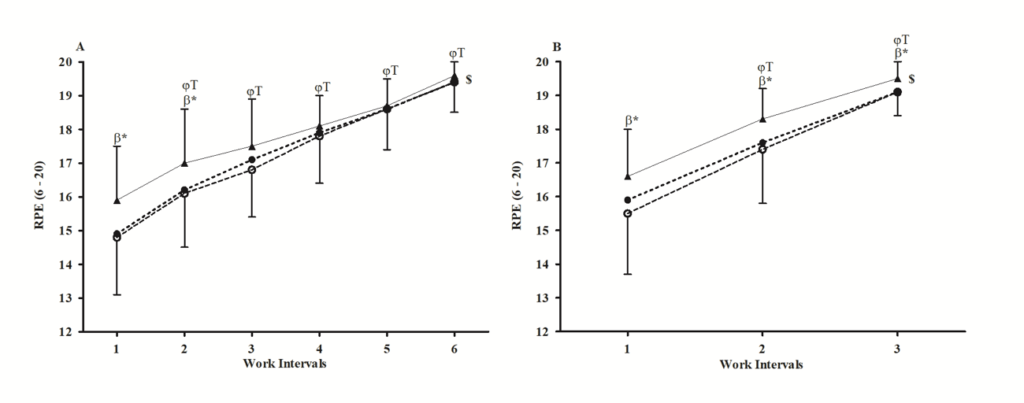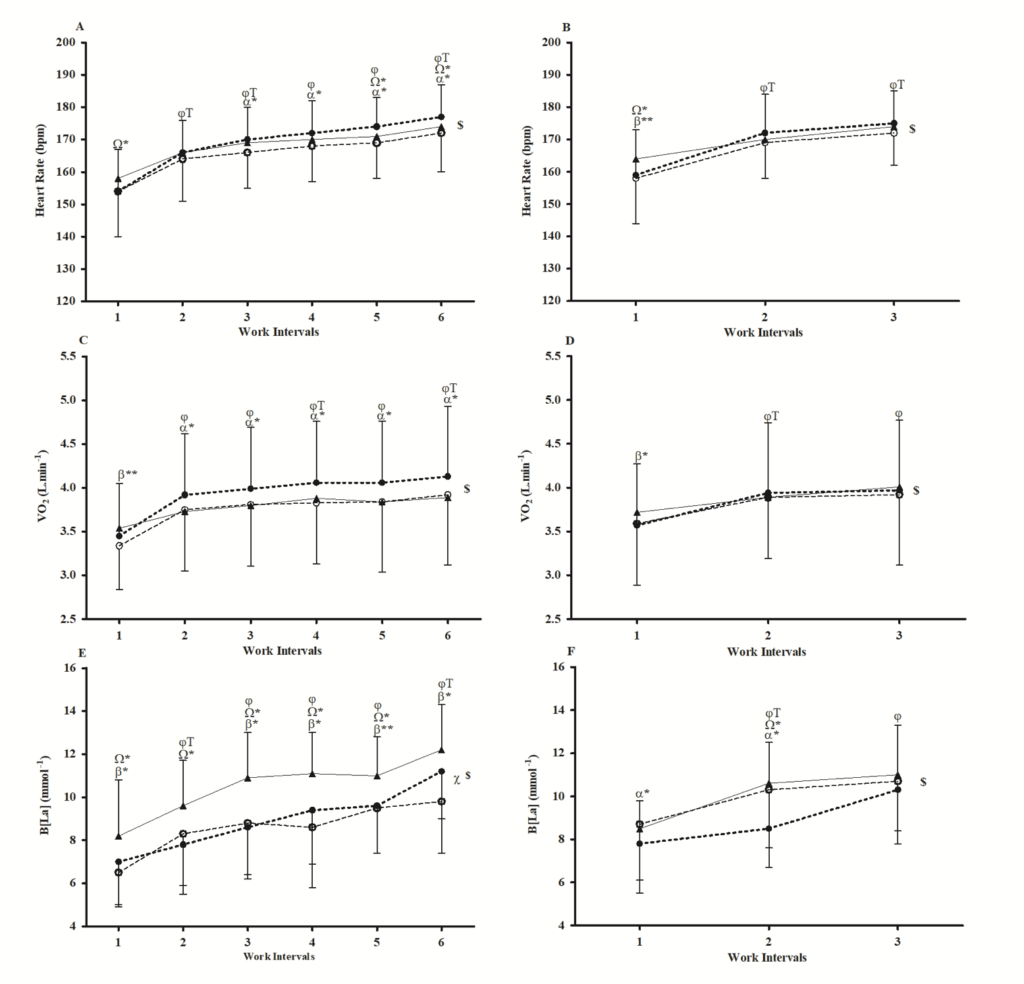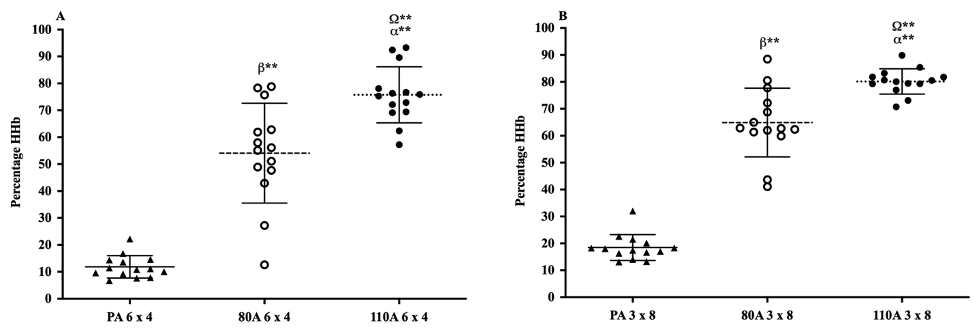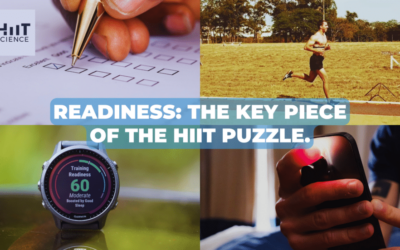Should I use active or passive recovery? What role does recovery intensity play in the time spent at high percentages of V̇O2max during HIIT?Indeed, active recovery is often employed in an attempt to increase the fractional contribution of aerobic metabolism and time near V̇O2max during HIIT. The rationale for this is that active recovery maintains a higher V̇O2 at the start of the subsequent work interval, which reduces the time to reach V̇O2max compared to passive recovery. Our recent work sought to investigate the role of recovery intensity on the physiological and perceptual responses during cycling based 6 x 4-min and 3 x 8-min HIIT sessions (10), which have been used previously in HIIT research to bring about training adaptation (11,12).
 Figure 1. The 12 variables that can be manipulated to prescribe different HIIT sessions (11). These include (1) work bout intensity, (2) duration of the work bout, (3) recovery period intensity, (4) recovery period duration, (5) number of intervals or series duration, (6) number of interval bout series, and (7) their between-series recovery duration, and (8) intensity. Variables 1 through 8 account for the (9) total work performed. Additionally, other factors that play a large role on the physiological outcome of an HIIT session are the (10) exercise mode and ground surface for run-based HIIT, (11) environment (heat and altitude), and (12) an athlete’s nutrition practices.
Figure 1. The 12 variables that can be manipulated to prescribe different HIIT sessions (11). These include (1) work bout intensity, (2) duration of the work bout, (3) recovery period intensity, (4) recovery period duration, (5) number of intervals or series duration, (6) number of interval bout series, and (7) their between-series recovery duration, and (8) intensity. Variables 1 through 8 account for the (9) total work performed. Additionally, other factors that play a large role on the physiological outcome of an HIIT session are the (10) exercise mode and ground surface for run-based HIIT, (11) environment (heat and altitude), and (12) an athlete’s nutrition practices.
The research
Fourteen well-trained cyclists (V̇O2peak: 62 ± 9 ml.kg-1.min-1) completed 6 x 4-min and 3 x 8-min HIIT sessions (2:1 work:recovery ratio) with three differing recovery intensity prescriptions: passive recovery, active recovery at 80% of lactate threshold (80A; 164 ± 35W) or active recovery at 110% of lactate threshold (110A; 225 ± 48W). Work intervals were prescribed as self-paced on a ‘maximal session effort’ basis (i.e. “isoeffort”), with participants instructed to achieve the highest power output possible during each interval. As shown in Figure 2, sessions would be considered Type 3 and Type 4 in the HIIT Science context (Ed.). Figure 2. Schematic of work and recovery intensities and durations used in the study.
Figure 2. Schematic of work and recovery intensities and durations used in the study.
The results
The main finding of the study was that the prescription of active recovery significantly reduced the work interval power output (Figure 3) and time spent >80%, >90% and >95% of maximal minute power (Table 1), in comparison to passive recovery intervals.

Figure 3. Mean work interval power output of the HIIT protocols. Ω Significant difference between PA & 110A. β Significant difference between PA & 80A. * = P < 0.05.
Despite the differences in work interval power output and time spent at high percentages of maximal minute power, there was no effect of recovery intensity on the time participants spent at >80%V̇O2peak (P = .10), >90%V̇O2peak (P = .11) and >95%V̇O2peak (P = .50) during the work intervals of the 6 x 4-min and 3 x 8-min HIIT sessions, despite passive recovery significantly reducing V̇O2 at the start of subsequent work intervals (Table 1). Table 1. Time spent above percentages of V̇O2peak and MMP during the work intervals (To make in Canva).. V̇O2peak, maximal oxygen consumption; MMP, maximal minute power. Ω Significant difference between PA & 110A. β Significant difference between PA & 80A. α Significant difference between 80A & 110A.
Table 1. Time spent above percentages of V̇O2peak and MMP during the work intervals (To make in Canva).. V̇O2peak, maximal oxygen consumption; MMP, maximal minute power. Ω Significant difference between PA & 110A. β Significant difference between PA & 80A. α Significant difference between 80A & 110A.
Despite within-session RPE being higher during the passive protocols (Figures 3A & B), participants reported significantly higher sRPE values at the end of the 110A (9.1 ± 0.5 and 9.1 ± 0.5) recovery protocol when compared to the 80A (8.7 ± 0.6 and 8.5 ± 0.6) and passive (8.3 ± 0.7 and 8.6 ± 0.7) recovery protocols during both HIIT sessions (P = < .001).
 Figure 3. (A/B) RPE. Data are displayed per work interval as mean ± SD for the 6 x 4-min and 3 x 8-min HIIT sessions with PA recovery intensity (closed triangles), 80A recovery intensity (open circles) and 110A recovery intensity (closed circles). φ Significant difference from interval 1. Т Significant difference from previous interval. β Significant difference between PA & 80A. * = P < 0.05. $ Main effect of work interval number (all P < 0.01).
Figure 3. (A/B) RPE. Data are displayed per work interval as mean ± SD for the 6 x 4-min and 3 x 8-min HIIT sessions with PA recovery intensity (closed triangles), 80A recovery intensity (open circles) and 110A recovery intensity (closed circles). φ Significant difference from interval 1. Т Significant difference from previous interval. β Significant difference between PA & 80A. * = P < 0.05. $ Main effect of work interval number (all P < 0.01).

Figure 4. (A/B) HR, (C/D) V̇O2, (E/F) B[La]. Data are displayed per work interval as mean ± SD for the 6 x 4-min and 3 x 8-min HIIT sessions with PA recovery intensity (closed triangles), 80A recovery intensity (open circles) and 110A recovery intensity (closed circles). φ Significant difference from interval 1. Т Significant difference from previous interval. Ω Significant difference between PA & 110A. β Significant difference between PA & 80A. α Significant difference between 80A & 110A. * = P < 0.05. ** = P < 0.001. X Main effect of recovery intensity (all P < 0.01). $ Main effect of work interval number (all P < 0.01).
Active recovery intervals increased the oxygen demand at the exercising muscle, as shown by the greater deoxygenation of the vastus lateralis muscle (P = < .001; Figures 5A & B).The increased deoxygenation of the vastus lateralis muscle (an important locomotor muscle during cycling performance) would potentially impair key recovery processes, such as adenosine triphosphate and phosphocreatine resynthesis, muscle lactate clearance and restoration of myoglobin stores which require the availability of oxygen (13).
The more complete recovery provided by the passive protocols may explain the participant’s ability to sustain higher work interval power outputs, when compared to the active recovery protocols.
 Figure 5. (A) percentage HHb during the last 30-s of the recovery intervals during the 6 x 4-min HIIT sessions, (B) percentage HHb during the last 30-s of the recovery intervals during the 3 x 8-min HIIT sessions. Values are Mean ± SD. Ω Significant difference between PA & 110A. β Significant difference between PA & 80A. α Significant difference between 80A & 110A. ** = P < 0.001.
Figure 5. (A) percentage HHb during the last 30-s of the recovery intervals during the 6 x 4-min HIIT sessions, (B) percentage HHb during the last 30-s of the recovery intervals during the 3 x 8-min HIIT sessions. Values are Mean ± SD. Ω Significant difference between PA & 110A. β Significant difference between PA & 80A. α Significant difference between 80A & 110A. ** = P < 0.001.
Conclusion and practical applications
- Active recovery at 80% and 110% of the lactate threshold significantly impaired work interval power output, when compared to passive recovery, but had a limited effect on the physiological stress of the work intervals during two closely matched HIIT designs.
- Maintaining an elevated V̇O2 by using active recovery was not necessary for reaching high fractions of V̇O2peak during subsequent work intervals.
- Passive recovery between long work intervals facilitated a higher external training load yet maintained a similar internal stress for a lower sRPE; this strategy therefore may be more the efficacious recovery intensity prescription.
- Active recovery intervals increased the oxygen demand at the exercising muscle, which would potentially impair key recovery processes. This may explain the ability to sustain higher work interval power outputs when using passive recovery.

About the Authors
 Christopher Fennell completed his BSc and MSc in Sport and Exercise Science. He is currently working as a Research Assistant at the School of Sport and Exercise Sciences, University of Kent, UK, before commencing his PhD in September 2021.
Christopher Fennell completed his BSc and MSc in Sport and Exercise Science. He is currently working as a Research Assistant at the School of Sport and Exercise Sciences, University of Kent, UK, before commencing his PhD in September 2021.
 James Hopker is a Professor of Sport and Exercise Science at the School of Sport and Exercise Sciences, University of Kent, UK.
James Hopker is a Professor of Sport and Exercise Science at the School of Sport and Exercise Sciences, University of Kent, UK.
References
- Tschakert G, Hofmann P (2013) High-intensity intermittent exercise: methodological and physiological aspects. Int J Sports Physiol Perform 8:600-610. https://doi.org/10.1123/ijspp.8.6.600.
- Schoenmakers PPJM, Hettinga FJ, Reed KE (2019) The moderating role of recovery durations in high-intensity interval-training protocols. Int J Sports Physiol Perform 31:1-9. https://doi.org/10.1123/ijspp.2018-0876.
- Barbosa LF, Denadai BS, Greco CC (2016) Endurance performance during severe-intensity intermittent cycling: effect of exercise duration and recovery type. Front Physiol 7:602. https://doi.org/10.3389/fphys.2016.00602.
- Coso JD, Hamouti N, Aguado-Jimenez R, Mora-Rodriguez R (2010) Restoration of blood pH between repeated bouts of high-intensity exercise: effects of various active-recovery protocols. Eur J Appl Physiol 108:523-532. https://doi.org/10.1007/s00421-009-1248-6.
- Dorado C, Sanchis-Moysi J, Calbet JAL (2004) Effects of recovery mode on performance, O2 uptake, and O2 deficit during high-intensity intermittent exercise. Can J Appl Physiol 29:227-244. https://doi.org/10.1139/h04-016.
- Monedero J, Donne B (2000) Effect of recovery interventions on lactate removal and subsequent performance. Int J Sports Med 21:593-597. https://doi.org/10.1055/s-2000-8488.
- McAinch AJ, Febbraio MA, Parkin JM, Zhao S, Tangalakis K, Stojanovska L, Carey MF (2004) Effect of active versus passive recovery on metabolism and performance during subsequent exercise. Int J Sport Nutr Exerc Metab 14:185-196. https://doi.org/10.1123/ijsnem.14.2.185.
- Siegler JC, Bell-Wilson J, Mermier C, Faria E, Robergs RA (2006) Active and passive recovery and acid-base kinetics following multiple bouts of intense exercise to exhaustion. Int J Sports Nutr Exerc Metab 16:92-107. https://doi.org/10.1123/ijsnem.16.1.92.
- Stanley J, Buchheit M (2014) Moderate recovery unnecessary to sustain high stroke volume during interval training. A brief report. J Sports Sci Med 13:393-396.
- Fennell CRJ, Hopker JG (2020) The acute physiological and perceptual effects of recovery interval intensity during cycling-based high-intensity interval training. Eur J Appl Physiol. https://doi.org/10.1007/s00421-020-04535-x.
- Stepto NK, Hawley JA, Dennis SC, Hopkins WG (1999) Effects of different interval-training programs on cycling time-trial performance. Med Sci Sports Exerc. 31:736-741. https://doi.org/10.1097/00005768-199905000-00018.
- Seiler S, Joranson K, Olesen BV, Hetlelid KJ (2011) Adaptations to aerobic interval training: interactive effects of exercise intensity and total work duration. Scan Med Sci Sports 23:74-83. https://doi.org/10.1111/j.1600-0838.2011.01351.x.
- Spencer M, Bishop D, Dawson B, Goodman C, Duffield R (2006) Metabolism and performance in repeated cycle sprints: active versus passive recovery. Med Sci Sports Exerc 38:1492-1499. https://doi.org/10.1249/01.mss.0000228944.62776.a7.







